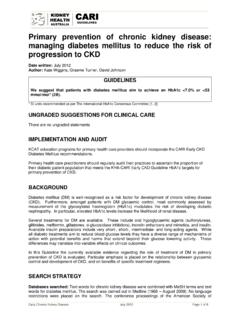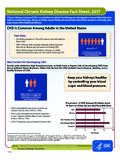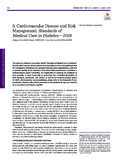Transcription of Preventing CHRONIC DISEASES a vital investment - WHO
1 PreventingCHRONIC DISEASESa vital investmentChronic disease risks and deaths are increasing rapidly, especially in low and middle income countries This growing threat is an underappreciated cause of poverty and hinders the macroeconomic development of many countries This part of the report reveals the extent of the CHRONIC disease pandemic, its relationship to poverty, and its adverse impact on countries macroeconomic development. A new global goal for reducing CHRONIC disease death rates over the next 10 years is also to face WITH CHRONIC DISEASEkey messagesMARIA SALONIKIY ears in search of the right SRIDHAR REDDYP aying the price of tobacco CONTENTS1 CHRONIC DISEASES : causes and health impacts342 CHRONIC DISEASES and poverty613 The economic impact of CHRONIC diseases74 SHAKEELA BEGUMTo buy or not to buy medication?803334 The disease profile of the world is changing at an astonishingly fast rate, especially in low and middle income countries.
2 Long-held notions about the nature of CHRONIC DISEASES , their occurrence, the risk factors underlying them and the populations at risk are no longer valid. The great epidemics of tomorrow are unlikely to resemble those that have previously swept the world, thanks to progress in infectious disease con-trol. The risk of outbreaks a new infl uenza pandemic, for example will require constant vigilance. But it is the looming epidemics of heart disease , stroke, cancer and other CHRONIC DISEASES that for the foresee-able future will take the greatest toll in deaths and is vitally important that the impending CHRONIC disease pandemic is recognized, understood and acted on DISEASES : causes and health impacts CHRONIC DISEASES will take the lives of over 35 million people in 2005, including many young people and those in middle ageThe total number of people dying from CHRONIC DISEASES is double that of all infectious DISEASES (including HIV/AIDS, tuberculosis and malaria), maternal and perinatal conditions, and nutritional defi ciencies combined80% of CHRONIC disease deaths occur in low and middle income countries and half are in womenWithout action to address the causes, deaths from CHRONIC DISEASES will increase by 17% between 2005 and 2015 35 Chapter One.
3 CHRONIC DISEASES : causes and health impactsWHAT ARE CHRONIC DISEASES ?The main CHRONIC DISEASES discussed in this report are: cardiovascular DISEASES , mainly heart disease and stroke; cancer; CHRONIC respiratory DISEASES ; and are many other CHRONIC conditions and DISEASES that contribute signifi cantly to the burden of disease on individuals, families, societies and countries. Examples include mental disorders, vision and hear-ing impairment, oral DISEASES , bone and joint disorders, and genetic disorders. Some will be presented as case studies in this publication to highlight the wide variety of CHRONIC DISEASES that require continuing attention from all sectors of society. Mental and neurological disorders are important CHRONIC conditions that share a unique set of distinguish-ing features, and which were reviewed recently by the World Health Organization (1).TERMINOLOGYPart of the confusion that surrounds CHRONIC DISEASES is that they appear under different names in different contexts.
4 Sometimes the term non-communicable DISEASES is used to make the distinction from infec-tious or communicable DISEASES . Yet several CHRONIC DISEASES have an infectious component to their cause, such as cervical cancer and liver cancer. Lifestyle-related DISEASES is a term sometimes used to emphasize the contribution of behaviour to the development of CHRONIC DISEASES . In fact, these DISEASES are heavily infl uenced by environmental conditions and are not the result of individual choices alone; lifestyles are, of course, equally important for communicable this report, the term CHRONIC DISEASES is preferred because it suggests important shared features:the CHRONIC disease epidemics take decades to become fully established they have their origins at young ages; given their long duration, there are many opportunities for prevention;they require a long-term and systematic approach to treatment; health services must integrate the response to these DISEASES with the response to acute, infectious DISEASES .
5 36 HEART DISEASET here are many forms of heart disease . Coronary heart disease , also known as coronary artery disease or ischaemic heart disease , is the leading cause of death globally. This is the form of heart disease con-sidered in this report and it will be referred to simply as heart disease . It is caused by disease of the blood vessels (atherosclerosis) of the heart, usually as part of the process which affects blood vessels more generally. Heart disease , although known for centuries, became common in the early decades of the 20th century in high income countries. The epidemics have now spread is a disease of the brain caused by interference to the blood supply. Stroke and heart disease are the main cardiovascular DISEASES . There are several types of strokes and the acute events are usually caused by the same long-term disease processes that lead to heart disease ; a small proportion of acute events are caused by a blood vessel bursting.
6 Stroke is the main cardiovascular disease in many east Asian describes a range of DISEASES in which abnormal cells proliferate and spread out of control. Other terms used are tumours and neoplasms. There are many types of cancer and all organs of the body can become cancerous. Tobacco is the main preventable cause of cancer. The causes of many other cancers are also known, including cervical cancer, skin cancer and oral cancer. CHRONIC RESPIRATORY DISEASESD iseases of the lung take many forms. This report focuses on CHRONIC obstructive pulmonary disease and asthma. CHRONIC obstructive pulmo-nary disease is caused by airfl ow limitation that is not fully reversible; asthma is caused by reversible obstruction of the airways. DIABETESD iabetes is characterized by raised blood glucose (sugar) levels. This results from a lack of the hormone insulin, which controls blood glucose levels, and/or an inability of the body s tissues to respond properly to insulin (a state called insulin resistance).
7 The most common type of diabetes is type 2, which accounts for about 90% of all diabetes37 Chapter One. CHRONIC DISEASES : causes and health impactsand is largely the result of excessive weight and physical inactivity. Until recently, this type of diabetes was seen only in adults but is now occurring in obese children. The usual childhood form of diabetes (type 1 diabetes ) is caused by an absolute lack of insulin and not by obesity. Without insulin, type 1 diabetes is rapidly disease PROFILESThis section summarizes the impact of CHRONIC DISEASES in differ-ent populations around the world. Detailed projections for 2005 are presented for males and females of all ages. The data presented are estimated by WHO using standard methods to maximize cross-country comparability; they are not necessarily the offi cial statistics of Member States. For more information on methods of projections for deaths and burden of disease , see Annex DISEASES are projected to take the lives of 35 million people in 2005, which is double the estimate for all infectious DISEASES combined.
8 Of these CHRONIC disease deaths, 16 million will occur in people under 70 years of age, and 80% will occur in low and middle income countries. Approximately half of the CHRONIC disease deaths occur in GLOBAL SITUATIONDEATHSA pproximately 58 million deaths are expected to occur in 2005. It is projected that 35 million or 60% of all deaths will be caused by CHRONIC DISEASES . To put these numbers into perspective, around 17 million deaths approximately 30% will be due to infectious DISEASES (including HIV/AIDS, tuberculosis and malaria), maternal and perinatal conditions, and nutritional defi ciencies combined. An additional 5 million deaths 9% of the total are expected to result from violence and injuries. It is often assumed that CHRONIC disease deaths are restricted to older people, but this is not the case. Approximately 16 million CHRONIC disease deaths occur each year in people under 70 years of age.
9 Moreover, CHRONIC disease deaths occur at much earlier ages in low and middle income countries than in high income fi gure on the next page shows the main causes of death worldwide for all ages. Cardiovascular DISEASES (mainly heart disease and stroke) are the leading cause of death, responsible for 30% of all deaths. 38 Cancer and CHRONIC respiratory DISEASES are the other leading causes of CHRONIC disease deaths. The contribution of diabetes is underesti-mated because although people may live for years with diabetes , their deaths are usually recorded as being caused by heart disease or kidney main causesof death, worldwide, all ages, 2005 Communicable DISEASES ,maternal and perinatalconditions, and nutritionaldeficiencies30%Injuries9%Card iovasculardiseases30%Cancer13%Other CHRONIC diseases9%Diabetes2%Chronicrespiratorydi seases7%TOTAL DEATHS 200558 millionThe number and rates of projected CHRONIC disease deaths in males and females for four age groups are shown in the table on the facing page.
10 The number of deaths is similar in males and females. The death rates for all CHRONIC DISEASES rise with increasing age but almost 45% of CHRONIC disease deaths occur prematurely, under the age of 70 years. 39 Chapter One. CHRONIC DISEASES : causes and health impactsProjected CHRONIC disease deaths,* worldwide, numbers and rates by age and sex, 2005 Age groupNumber of deaths (millions)Death rates per 100 000 MalesFemalesTotalMalesFemalesTotal0 5943737225131160 6943723281533191170 and over91120698161026467 Total all ages181735556543549* Shown to rounded numbers. Components may not add to total exactly owing to main causesof global burden of disease (DALYs),worldwide,all ages, 2005 Communicable DISEASES ,maternal and perinatalconditions, and nutritionaldeficiencies39%Injuries13%Car diovasculardiseases10%Cancer5%Otherchron ic diseases28%Diabetes1%Chronicrespiratoryd iseases4%BURDEN OF DISEASEAs well as a high death toll, CHRONIC DISEASES also cause disability, often for decades of a person s life.

















